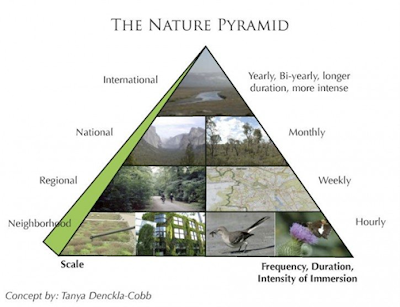Tanya Denckla Cobb, from the University of Virginia, developed the idea of the Nature Pyramid, where we experience various amounts of spending time in nature and to different degrees. In 2012, Tim Beatley, Founder and Executive Director of the Biophilic Cities Project, turned the concept into a graphic depiction and gave further explanation in his article, Exploring the Nature Pyramid. The pyramid has been replicated through the years by various organizations and with a variety of dosages.
However, access to outdoor spaces is limited for many children and families. In her book, Nature Fix, Florence Williams describes, “The research showed that income-related health disparities were greatest in areas with the least green”. What practices or measures has your organization taken to address accessibility for families from lower socioeconomic communities? The Minnesota Children’s Outdoor Bill of Rights lists fifteen experiences that all youth and children should be able to participate in:
- Experience Minnesota’s four seasons
- Explore and play outdoors in a safe, welcoming, and culturally affirming place
- Splash, play, or swim in rivers, lakes, ponds, and community pools
- Plant a tree and watch it grow
- Start or participate in an urban, community, or personal garden or farm
- Compost and recycle for a healthy environment
- Bike, ride, or ski a public trail
- Camp under the stars and safely build a campfire
- Catch and eat a fish
- Hike, hunt, or forage on public lands
- Boat or paddle on one of our 11,842 lakes
- Participate in outdoor sports and recreational activities
- Create art and attend outdoor concerts, festivals, and community events centered in nature
- Participate in traditions and culturally specific ancestral practices rooted in nature
- Protect and preserve our environment for future generations
As youth practitioners, we can create programming to deliver the various doses of nature and avenues for ALL children and youth to experience their rights in outdoors spaces. How can you apply the concept of scaffolding outdoor experiences to your programming?
You are welcome to comment on this blog post. We encourage civil discourse, including spirited disagreement. We will delete comments that contain profanity, pornography or hate speech--any remarks that attack or demean people because of their sex, race, ethnic group, etc.--as well as spam.

In the past, I worked at an environmental learning center, and I think one of the biggest barriers for getting kids outside in all seasons is access to appropriate clothing, and even more than that, people's knowledge of what appropriate clothing is. The number of times we had to explain the importance of wool socks for winter field days is immense! If you want to take youth outside in more extreme weather, and thereby reduce some of the fear around more extreme weather, you have to educate families on how to be safe and then be able to help them find solutions if they don't have the funds to access what they need.
ReplyDelete